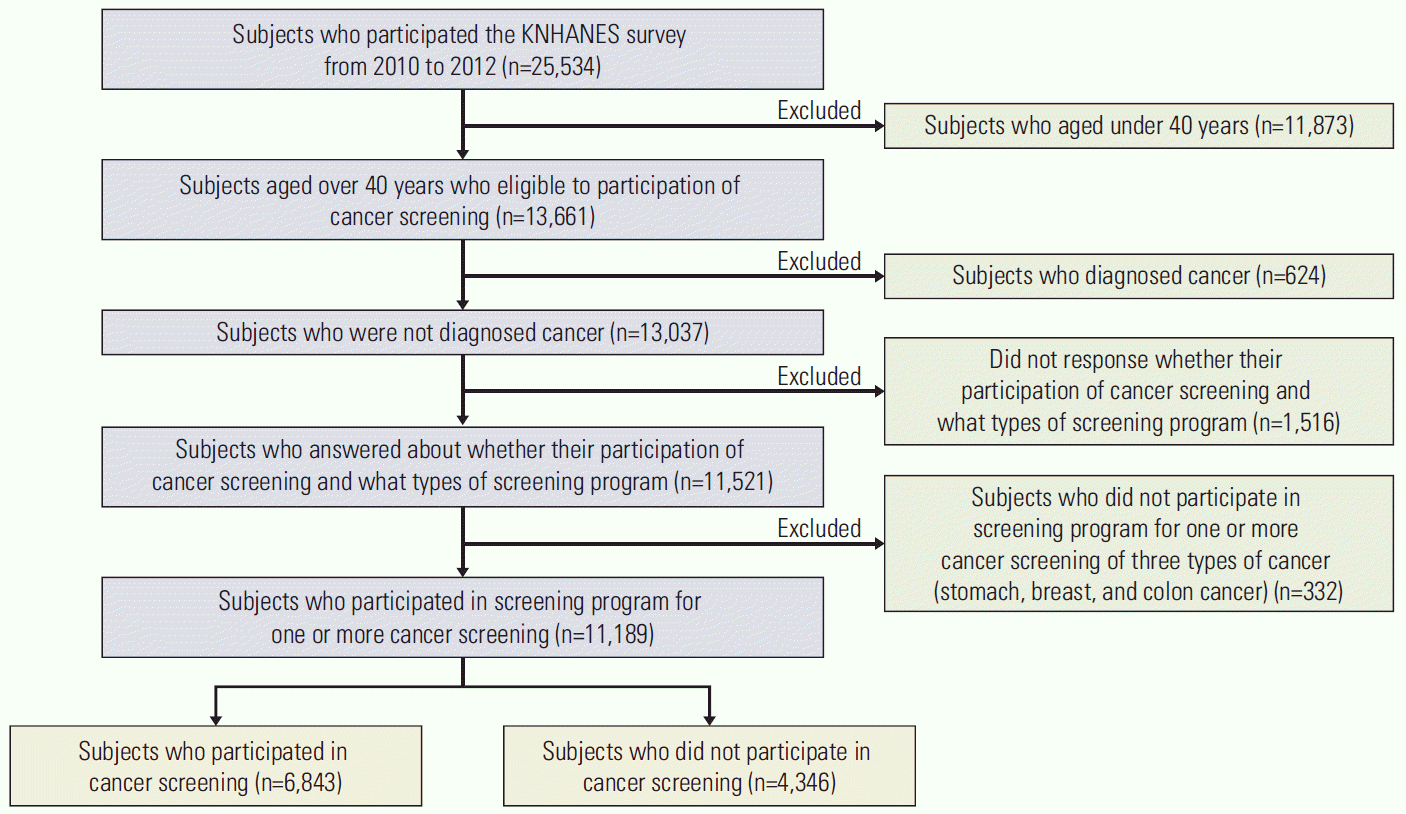1. Korean National Statistical Office. Annual report on the cause of death statistics in 2014. Daejeon: Korean National Statistical Office;2015.
2. Hahm MI, Choi KS, Park EC, Kwak MS, Lee HY, Hwang SS. Personal background and cognitive factors as predictors of the intention to be screened for stomach cancer. Cancer Epidemiol Biomarkers Prev. 2008; 17:2473–9.

3. Ministry of Health and Welfare. A guide for National Cancer Screening Program in 2015. Sejong: Ministry of Health and Welfare;2015.
4. Lee HY, Park EC, Jun JK, Hahm MI, Jung KW, Kim Y, et al. Trends in socioeconomic disparities in organized and opportunistic gastric cancer screening in Korea (2005-2009). Cancer Epidemiol Biomarkers Prev. 2010; 19:1919–26.

5. Kim MH, Kim CY, Park YK, Park YY, Cho HJ. How did health examination including screening developed to a industry? Seoul: People's Health Institute;2015.
6. Kim KH, Park EC, Hahm MI. The gap between physicians and the public in satisfaction with the National Health Insurance system in Korea. J Korean Med Sci. 2012; 27:579–85.

7. Yeo JY, Jeong HS. Determinants of health screening and its effects on health behaviors. Health Policy Manag. 2012; 22:49–64.

8. Hahm MI, Choi KS, Lee HY, Jun JK, Oh D, Park EC. Who participates in the gastric cancer screening and on-time rescreening in the National Cancer Screening Program? A population-based study in Korea. Cancer Sci. 2011; 102:2241–7.

9. Mahabaleshwarkar R, Khanna R, West-Strum D, Yang Y. Association between health-related quality of life and colorectal cancer screening. Popul Health Manag. 2013; 16:178–89.

10. Kang M, Yoo KB, Park EC, Kwon K, Kim G, Kim DR, et al. Factors associated with organized and opportunistic cancer screening: results of the Korea National Health and Nutrition Examination Survey (KNHANES) 2007-2011. Asian Pac J Cancer Prev. 2014; 15:3279–86.

11. Park K, Park JH, Park JH, Kim HJ, Park BY. Does health status influence intention regarding screening mammography? Jpn J Clin Oncol. 2010; 40:227–33.

12. Deshpande AD, McQueen A, Coups EJ. Different effects of multiple health status indicators on breast and colorectal cancer screening in a nationally representative US sample. Cancer Epidemiol. 2012; 36:270–5.

13. Suzuki R, Wallace PM, Small E. Race, health-related quality of life and colorectal cancer screening rates in the National Health Interview Survey. Am J Health Behav. 2015; 39:132–9.

14. Gandhi PK, Gentry WM, Kibert JL 2nd, Lee EY, Jordan W, Bottorff MB, et al. The relationship between four health-related quality-of-life indicators and use of mammography and Pap test screening in US women. Qual Life Res. 2015; 24:2113–28.

15. Korean Centers for Disease Control and Prevention. National Health and Nutrition Examination Survey: Analytic Guideline (2010-2012). Osong: Korean Centes for Disease Control and Prevention;2014.
16. Jung KW, Won YJ, Kong HJ, Oh CM, Cho H, Lee DH, et al. Cancer statistics in Korea: incidence, mortality, survival, and prevalence in 2012. Cancer Res Treat. 2015; 47:127–41.

17. Lee WC. Evidence-based National Cancer Screening Program of Korea. J Korean Med Assoc. 2011; 54:1028–35.

18. Suh M, Choi KS, Park B, Lee YY, Jun JK, Lee DH, et al. Trends in cancer screening rates among Korean men and women: results of the Korean National Cancer Screening Survey, 2004-2013. Cancer Res Treat. 2016; 48:1–10.

19. Hong JY, Kim SY, Chung KS, Kim EY, Jung JY, Park MS, et al. Factors associated with the quality of life of Korean COPD patients as measured by the EQ-5D. Qual Life Res. 2015; 24:2549–58.

20. EuroQol. EQ-5D-3L user guide: basic information on how to use the EQ-5D-3L instrument. Rotterdam: EuroQol;2013.
21. Suh M, Choi KS, Lee HY, Hahm MI, Lee YY, Jun JK, et al. Socioeconomic disparities in colorectal cancer screening in Korea: a nationwide cross-sectional study. Medicine (Baltimore). 2015; 94:e1368.
22. Myong JP, Shin JY, Kim SJ. Factors associated with participation in colorectal cancer screening in Korea: the Fourth Korean National Health and Nutrition Examination Survey (KNHANES IV). Int J Colorectal Dis. 2012; 27:1061–9.

23. Cho J, Guallar E, Hsu YJ, Shin DW, Lee WC. A comparison of cancer screening practices in cancer survivors and in the general population: the Korean national health and nutrition examination survey (KNHANES) 2001-2007. Cancer Causes Control. 2010; 21:2203–12.

24. Kwon YM, Lim HT, Lee K, Cho BL, Park MS, Son KY, et al. Factors associated with use of gastric cancer screening services in Korea. World J Gastroenterol. 2009; 15:3653–9.

25. Pizzo E, Pezzoli A, Stockbrugger R, Bracci E, Vagnoni E, Gullini S. Screenee perception and health-related quality of life in colorectal cancer screening: a review. Value Health. 2011; 14:152–9.

26. Lipkus IM, Lyna PR, Rimer BK. Colorectal cancer risk perceptions and screening intentions in a minority population. J Natl Med Assoc. 2000; 92:492–500.
27. Abolfotouh MA, BaniMustafa AA, Mahfouz AA, Al-Assiri MH, Al-Juhani AF, Alaskar AS. Using the health belief model to predict breast self examination among Saudi women. BMC Public Health. 2015; 15:1163.

28. Walker MJ, Mirea L, Glendon G, Ritvo P, Andrulis IL, Knight JA, et al. Does perceived risk predict breast cancer screening use? Findings from a prospective cohort study of female relatives from the Ontario site of the breast cancer family registry. Breast. 2014; 23:482–8.

29. Kim JH, Park EC, Yoo KB. Impact of perceived cancer risk on the cancer screening rate in the general Korean population: results from the Korean health panel survey data. Asian Pac J Cancer Prev. 2014; 15:10525–9.

30. Li J, Hart TL, Aronson M, Crangle C, Govindarajan A. Cancer worry, perceived risk and cancer screening in first-degree relatives of patients with familial gastric cancer. J Genet Couns. 2016; 25:520–8.





 PDF
PDF Citation
Citation Print
Print



 XML Download
XML Download